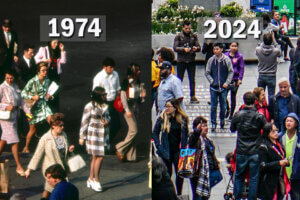West Long Branch, NJ – The number of Americans who plan to stay home for the Thanksgiving holiday will nearly double this year, according to the Monmouth (“Mon-muth”) University Poll. Most say there will be fewer people around the holiday table, although these plans differ based on political affiliation. One-fourth of the country plans to use remote video such as Zoom to include family and friends in the festivities this year. Half of Americans say they are very concerned about someone in their family getting seriously ill from Covid – a number that matches the prior high back in April.
Fully 74% of Americans will enjoy Thanksgiving dinner in their own home this year, which is a significantly larger number than those who say they usually stay home for the holiday (44%). Fewer than 1 in 4 Americans will be traveling next week, including 10% who plan an overnight stay and 13% who plan to drive to a place and back on Thursday. In a typical year, just over half usually travel for Thanksgiving – 23% say they typically include an overnight stay and 30% drive the same day.
Those who plan to stay home this year include 66% of 18 to 34 year olds (higher than 38% who say they usually stay home), 73% of 35 to 54 year olds (versus 41% usually), and 84% of those aged 55 and older (versus 53% usually).
Among people who normally include an overnight stay for the holiday, 57% will remain home this year and among those who usually drive to a place and back on Thanksgiving Day, 67% will stay put next week. At the opposite end of the spectrum, among those who normally stay home, 1 in 10 actually plan to travel this year.
“The first big national family holiday during Covid will be a very different experience for most Americans,” said Patrick Murray, director of the independent Monmouth University Polling Institute. The poll was conducted before the CDC issued its recommendation on Thursday against traveling during the Thanksgiving period.
Most Americans (53%) say their in-person Thanksgiving Day gathering will be smaller than usual this year, although 24% plan to have friends and family join them virtually by Zoom or video for dinner. Just under half of the American public will spend the holiday either with members of their immediate household only (37%) or on their own (8%). Another 45% say there will be a small number of additional family members or friends around the table this year while 8% plan to spend the day with a large group of people. Democrats (68%) and independents (55%) are more likely than Republicans (37%) to be holding a smaller than usual holiday gathering this year.
“As we have seen in so many other aspects of the pandemic, the extent to which people choose to take extra precautions for Thanksgiving is being driven in part by politics,” said Murray.
Half (50%) of the public is very concerned about someone in their family becoming seriously ill from Covid and another 25% are somewhat concerned. Just 13% are not too concerned and 10% are not at all concerned. The percentage who are very concerned matches the prior high of 50% recorded back in April. Since then, this number ranged between 37% and 42% from the late spring through the summer before rising to 47% in September.
People of color (62%) are more likely than non-Hispanic whites (42%) to be very concerned about a family member becoming seriously ill from the virus. Also, Democrats (73%) are more likely than independents (49%) and Republicans (32%) to be very concerned. These demographic differences have been present since the beginning of the pandemic.
A majority (54%) of Americans say the coronavirus outbreak has had a major impact on their lives, 29% say it has had a minor impact, and 17% say it has had no impact. These results have been fairly consistent since the summer.
The Monmouth University Poll was conducted by telephone from November 12 to 16, 2020 with 810 adults in the United States. The question results in this release have a margin of error of +/- 3.5 percentage points. The poll was conducted by the Monmouth University Polling Institute in West Long Branch, NJ.
QUESTIONS AND RESULTS
(* Some columns may not add to 100% due to rounding.)
[Q1-8 and Q10-27 previously released.]
[Q9 and Q28-30 held for future release.]
31.Thinking about you personally, has the coronavirus outbreak had a major impact, minor impact, or no real impact on your own daily life?
| TREND: | Nov. 2020 | Early Sept. 2020 | Early June 2020 | May 2020 | April 2020 | March 2020 |
| Major impact | 54% | 55% | 50% | 56% | 62% | 53% |
| Minor impact | 29% | 29% | 35% | 31% | 27% | 32% |
| No impact | 17% | 16% | 15% | 13% | 10% | 15% |
| (VOL) Don’t know | 0% | 0% | 0% | 0% | 1% | 0% |
| (n) | (810) | (867) | (807) | (808) | (857) | (851) |
32.How concerned are you about someone in your family becoming seriously ill from the coronavirus outbreak – very concerned, somewhat concerned, not too concerned, or not at all concerned?
| TREND: | Nov. 2020 | Early Sept. 2020 | Aug. 2020 | Late June 2020 | Early June 2020 | May 2020 | April 2020 | March 2020 |
| Very concerned | 50% | 47% | 41% | 41% | 37% | 42% | 50% | 38% |
| Somewhat concerned | 25% | 27% | 28% | 26% | 32% | 28% | 33% | 32% |
| Not too concerned | 13% | 13% | 18% | 17% | 14% | 14% | 9% | 18% |
| Not at all concerned | 10% | 12% | 13% | 15% | 16% | 16% | 7% | 12% |
| (VOL) Don’t know | 0% | 0% | 0% | 0% | 0% | 0% | 0% | 0% |
| (VOL) Has already happened | 1% | 0% | 1% | 1% | 0% | 0% | 0% | n/a |
| (n) | (810) | (867) | (868) | (867) | (807) | (808) | (857) | (851) |
33A.Looking ahead to the holidays, will you travel for Thanksgiving to someplace that involves an overnight stay, drive to another place and back the same day, or stay home?
| Nov. 2020 | |
| Travel overnight | 10% |
| Drive same day | 13% |
| Stay home | 74% |
| (VOL) Don’t know | 3% |
| (n) | (810) |
33B.Before this year, did you usually travel with an overnight stay for Thanksgiving, drive to another place and back the same day, or stay home?
| Nov. 2020 | |
| Travel overnight | 23% |
| Drive same day | 30% |
| Stay home | 44% |
| (VOL) Mix | 2% |
| (VOL) Don’t know | 0% |
| (n) | (810) |
34A.Will you spend this Thanksgiving alone, with just the members of your household, with a small number of additional family members or friends, or with a large number of family or friends? Please count only those who will be with you physically in person.
| Nov. 2020 | |
| Alone | 8% |
| Just the members of your household | 37% |
| A small number of additional family members or friends | 45% |
| A large number of family or friends | 8% |
| (VOL) Don’t know | 2% |
| (n) | (810) |
34B.And does that mean you will spend this Thanksgiving with about the same number of people as usual, fewer people than usual, or more people than usual?
| Nov. 2020 | |
| Same | 42% |
| Fewer | 53% |
| More | 4% |
| (VOL) Don’t know | 1% |
| (n) | (810) |
35.And will you have family or friends joining you for Thanksgiving dinner this year remotely by Zoom or video?
| Nov. 2020 | |
| Yes | 24% |
| No | 72% |
| (VOL) Don’t know | 4% |
| (n) | (810) |
[Q36-41 held for future release.]
METHODOLOGY
The Monmouth University Poll was sponsored and conducted by the Monmouth University Polling Institute from November 12 to 16, 2020 with a national random sample of 810 adults age 18 and older. This includes 289 contacted by a live interviewer on a landline telephone and 521 contacted by a live interviewer on a cell phone, in English. Telephone numbers were selected through random digit dialing and landline respondents were selected with a modified Troldahl-Carter youngest adult household screen. Monmouth is responsible for all aspects of the survey design, data weighting and analysis. The full sample is weighted for region, age, education, gender and race based on US Census information (ACS 2018 one-year survey). Data collection support provided by Braun Research (field) and Dynata (RDD sample). For results based on this sample, one can say with 95% confidence that the error attributable to sampling has a maximum margin of plus or minus 3.5 percentage points (unadjusted for sample design). Sampling error can be larger for sub-groups (see table below). In addition to sampling error, one should bear in mind that question wording and practical difficulties in conducting surveys can introduce error or bias into the findings of opinion polls.
| DEMOGRAPHICS (weighted) |
| Self-Reported |
| 32% Republican |
| 41% Independent |
| 28% Democrat |
| 48% Male |
| 52% Female |
| 31% 18-34 |
| 32% 35-54 |
| 37% 55+ |
| 63% White |
| 13% Black |
| 17% Hispanic |
| 8% Asian/Other |
| 70% No degree |
| 30% 4 year degree |
Click on pdf file link below for full methodology and crosstabs by key demographic groups.




